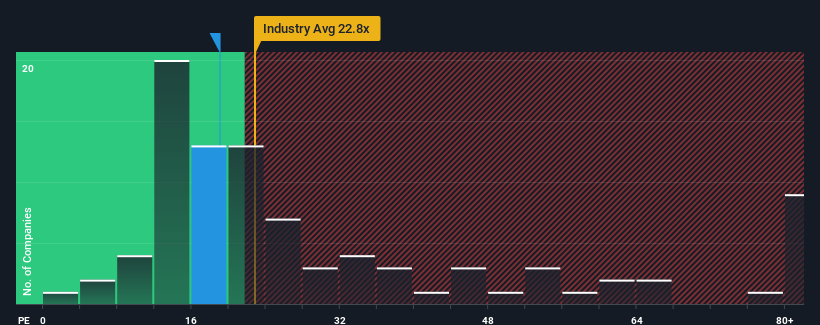- China
- /
- Renewable Energy
- /
- SZSE:002616
Investors Don't See Light At End Of Guangdong Chant Group Inc.'s (SZSE:002616) Tunnel

When close to half the companies in China have price-to-earnings ratios (or "P/E's") above 30x, you may consider Guangdong Chant Group Inc. (SZSE:002616) as an attractive investment with its 19x P/E ratio. Nonetheless, we'd need to dig a little deeper to determine if there is a rational basis for the reduced P/E.
Guangdong Chant Group certainly has been doing a great job lately as it's been growing earnings at a really rapid pace. It might be that many expect the strong earnings performance to degrade substantially, which has repressed the P/E. If that doesn't eventuate, then existing shareholders have reason to be quite optimistic about the future direction of the share price.
Check out our latest analysis for Guangdong Chant Group

Does Growth Match The Low P/E?
There's an inherent assumption that a company should underperform the market for P/E ratios like Guangdong Chant Group's to be considered reasonable.
Taking a look back first, we see that the company grew earnings per share by an impressive 108% last year. Despite this strong recent growth, it's still struggling to catch up as its three-year EPS frustratingly shrank by 55% overall. Accordingly, shareholders would have felt downbeat about the medium-term rates of earnings growth.
Weighing that medium-term earnings trajectory against the broader market's one-year forecast for expansion of 36% shows it's an unpleasant look.
In light of this, it's understandable that Guangdong Chant Group's P/E would sit below the majority of other companies. Nonetheless, there's no guarantee the P/E has reached a floor yet with earnings going in reverse. Even just maintaining these prices could be difficult to achieve as recent earnings trends are already weighing down the shares.
The Key Takeaway
We'd say the price-to-earnings ratio's power isn't primarily as a valuation instrument but rather to gauge current investor sentiment and future expectations.
As we suspected, our examination of Guangdong Chant Group revealed its shrinking earnings over the medium-term are contributing to its low P/E, given the market is set to grow. At this stage investors feel the potential for an improvement in earnings isn't great enough to justify a higher P/E ratio. Unless the recent medium-term conditions improve, they will continue to form a barrier for the share price around these levels.
There are also other vital risk factors to consider and we've discovered 3 warning signs for Guangdong Chant Group (2 are concerning!) that you should be aware of before investing here.
If you're unsure about the strength of Guangdong Chant Group's business, why not explore our interactive list of stocks with solid business fundamentals for some other companies you may have missed.
New: Manage All Your Stock Portfolios in One Place
We've created the ultimate portfolio companion for stock investors, and it's free.
• Connect an unlimited number of Portfolios and see your total in one currency
• Be alerted to new Warning Signs or Risks via email or mobile
• Track the Fair Value of your stocks
Have feedback on this article? Concerned about the content? Get in touch with us directly. Alternatively, email editorial-team (at) simplywallst.com.
This article by Simply Wall St is general in nature. We provide commentary based on historical data and analyst forecasts only using an unbiased methodology and our articles are not intended to be financial advice. It does not constitute a recommendation to buy or sell any stock, and does not take account of your objectives, or your financial situation. We aim to bring you long-term focused analysis driven by fundamental data. Note that our analysis may not factor in the latest price-sensitive company announcements or qualitative material. Simply Wall St has no position in any stocks mentioned.
About SZSE:002616
Guangdong Chant Group
Operates in the environmental thermal energy business in China.
Proven track record and fair value.
Similar Companies
Market Insights
Community Narratives


